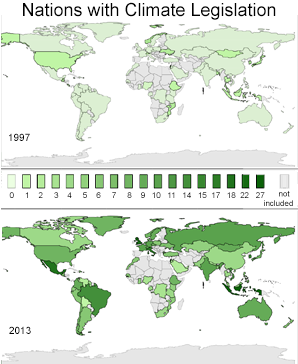The climate change research and data (and the weather outside your door) has become so compelling that the world is finally moving on from debating the issue to figuring out how to adapt and mitigate the worst effects that are increasing rapidly coming at us.
And, of course, the reason isn’t simply the data. It’s the money!! I always say that if you want to understand why and how things change,
“follow the money”.
Economies are starting to feel the pain in dollars and cents (or Euros or Pesos or Yen…). And, it penetrates our cultures in many ways such as health care costs when people can’t breath in Beijing and not only get sick but can’t work. Or land planes there and they have to close the airport because the visibility is so low.
But even more than costs, enterprising businesses are beginning to see the enormous economic opportunity that is available to those that develop the resources to solve the problem and understand that implementing solutions will benefit economies, jobs and tax revenues.
And finally, the economic powers that be are pushing their governments (read: campaign contributions) to get on with solving the problem.
Now just watch… here comes the tsunami of change and faster than you can imagine.
PS: Quit complaining about China. They get it and are actually moving faster than the US in many ways already. See below.
[divider scroll_text=””]
Legislation to control climate change begins to circle the globe
Lisa Friedman, E&E reporter
Published: Thursday, February 27, 2014
A global groundswell is rising from Beijing to Berlin, according to a new study Senate Democrats will release today that indicates nations are establishing domestic climate legislation at a rapid pace.
The analysis of 66 countries, including E.U. member states, accounting for the bulk of greenhouse gas emissions finds that 61 have passed climate and clean energy laws. All told, there are now more than 500 laws addressing climate change worldwide — compared to less than 40 when the Kyoto Protocol, the world’s first global warming treaty, went into effect nearly two decades ago.
It’s also up significantly from 2009, when President Obama met with the leaders of China, India and other countries in Copenhagen, Denmark, where they were unsuccessful in crafting a new legally binding successor to the Kyoto Protocol. With an attempt at yet another new deal on the horizon in Paris in 2015, leaders say domestic action is finally starting to drive the global negotiations.
“While we are all looking in a sense at 2015 with anticipation and concern, countries are acting on the prospect of global warming affecting their economies,” said Executive Director of the U.N. Environment Programme Achim Steiner.

[+] Laws attempting to reduce greenhouse gas emissions have proliferated since 1997, when the Kyoto Protocol was created. Charts courtesy of Globe International.
“A year before Copenhagen, the world was looking for some sort of magic wand,” he said. “Since then, there has been a period of recovering, with countries refocusing on their national agendas. A year before Paris, what we have now is a sense of pragmatism.”
Sen. Edward Markey (D-Mass.) will unveil the report at a high-level summit in the Senate Russell Building, joined by Democrats Sen. Barbara Boxer of California and House Minority Leader Nancy Pelosi. Lawmakers from dozens of countries are expected to attend, with leaders from Steiner to U.N. climate chief Christiana Figueres making a push for even more domestic action before 2015.
They are emphasizing the need for further action because no matter how impressive the growth of climate laws, experts said, they are still not enough to ensure that the global average temperature rise remains below 2 degrees over preindustrial levels — the point at which scientists warn catastrophic damage will occur.
Produced by the Global Legislators Organization (GLOBE International) and the Grantham Research Institute on Climate Change and the Environment, the study is the fourth deep dive into what countries are doing domestically to address climate change. It has steadily grown to include more countries from various stages of economic development and to represent a larger share of emissions.
Developing countries join in
While industrialized countries continue to have more laws aimed at ratcheting down emissions and boosting clean energy than poorer countries, the authors note that developing countries have “started to close the gap by passing sophisticated new legislation.” Sub-Saharan Africa and Latin America, in particular, the report notes, are developing serious new policies for climate action.
GLOBE Deputy Secretary General Terry Townshend said having the international spotlight shine on a country has been a key driver of legislative action. Indonesia and Mexico, for example, both emerged with national plans as they prepared to host U.N. climate conferences. Peru, which will host a negotiating session in December, is developing new legislative efforts, Townshend said.
Others, he noted, take a page from their neighbors. Latin American countries, including El Salvador, Ecuador, Bolivia and Guatemala, were “heavily influenced” by Mexico’s 2012 General Law on Climate Change and later its Climate Change National System.
In the United States, meanwhile, the landscape for legislation remains “challenging,” as the report delicately puts it. But, the authors note, while no climate laws are on the books, Obama is using executive authority under the Clean Air Act to regulate power plant emissions as well as to prepare for the impacts of climate change.
China, by contrast, has established its 12th five-year plan, which includes targets to reduce the country’s carbon intensity by 17 percent by 2015; decrease energy intensity by 16 percent; increase the share of non-fossil fuel primary energy consumption to 11.4 percent; and increase forest coverage by 21.6 percent, the report notes.
Diversity of approaches
“It’s clear in the last few years that the legislative momentum is shifting toward developing countries,” Townshend said. He called that a good thing, arguing that the more domestic legislation is in place around the world, the greater are the chances of securing a global agreement.
“It’s clearly a two-way relationship. Countries are prepared to go further internationally if they’ve passed domestic laws,” he said.
Diplomats have already agreed that a 2015 deal will apply to all countries — a major change from the Kyoto era, in which only wealthy countries were obligated to cut carbon. But many question whether the new agreement will have teeth.
The United States, for one, has argued that the best way to bring a large number of countries — including China and India — to the table is to make emissions targets voluntary. U.S. Special Envoy for Climate Change Todd Stern has argued that the real key is to ensure that carbon-cutting pledges are binding domestically, rather than internationally.
But with the world’s existing climate laws still not enough to limit the global average temperature rise to a safe level, advocates warn it is not enough to simply tie a bow around them and call them a climate agreement.
“The report shows the wide diversity of approaches countries are taking to address climate change, which an international agreement will need to accommodate. It also shows the need for accountability. A meaningful agreement will need to compel countries to demonstrate that they’re actually implementing their policies and producing tangible results,” said Elliot Diringer, executive vice president of the Center for Climate and Energy Solutions.


